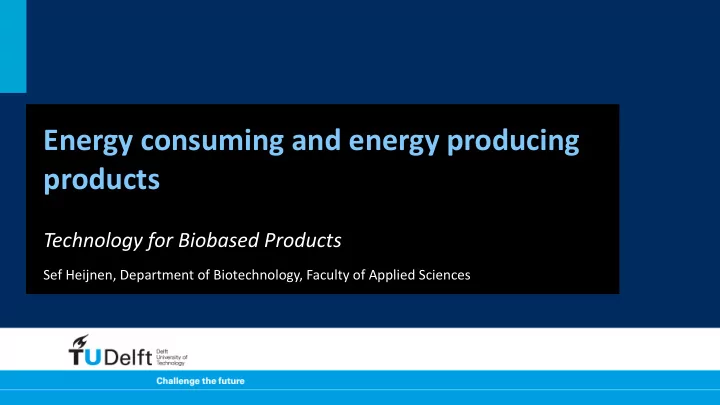

Energy consuming and energy producing products Technology for Biobased Products Sef Heijnen, Department of Biotechnology, Faculty of Applied Sciences
Pseudo steady state flux coupling Substrate limitation à q s (c s ) (constant T, pH, pressure) q p (c s ) μ(c s ) Black q s (c s ) box q CO2 (c s ) q i (c s ) Product consumes energy = aerobic Product produces energy = anaerobic
Substrate uptake Energy consuming and energy producing product c Hyperbolic function of q s = q q ,max * s s s + K c s s q s Parameters q s,max and K s • Assumed to be constant c s • Need to be determined • Depends on organism, substrate, T and pH
Substrate for maintenance energy Degradation Repair energy Leakage m s Energy consuming product Energy producing product Aerobic Anaerobic m s = 0.005 (mol glucose/h)/mol x m s = 0.05 (mol glucose/h)/mol x
Black box model energy consuming product μ(c s ) Branchpoint mol s |a| mol x mol s |b| mol p q s (c s ) q p (c s ) |m s | growth product maintenance q s = a*μ + b*q p + m s Herbert-Pirt substrate distribution relation Kinetic coupling of q p and μ q p (μ) = non-linear
Aerobic black box PDO model Glucose uptake rate -q s = 0.20 c s / (0.5 + c s ) product maintenance growth Herbert-Pirt substrate distribution -q s = 0.25 μ + 0.8 q p + 0.005 Non-linear q p (μ) relation q p = 0.05 μ /(0.03 + μ) 3 equations = 1 free variable which can be μ or c s 4 variables
Economics aerobic PDO production q s 0.25 μ + 0.8 q p + 0.005 = = mol glucose q p 0.05 μ /(0.03 + μ) mol PDO 0.25 μ + 0.8 + 0.005 . |q s /q p |= 0.05 μ /(0.03 + μ) 0.05 μ /(0.03 + μ) |q s /q p |= mol glucose = 1.05 + 5μ + 0.003/μ mol PDO
Economics aerobic PDO production 4.5 mol glucose 4 mol x / h μ opt = 0.0245 mol PDO mol x in fermenter 3.5 mol PDO / h q p,opt = 0.0227 3 mol x in fermenter 2.5 mol glucose / h q s,opt = 0.0294 mol x in fermenter 2 1.5 1 0.80 Herbert-Pirt 0.5 0 mol glucose 0.0294 0 0.1 0.2 0.3 =|q s /q p |= =1.29 μ (h -1 ) mol PDO 0.0227 |q s /q p |= mol glucose = 1.05 + 5μ + 0.003/μ mol PDO
Economics aerobic PDO production -q s,opt = 0.25 μ ,opt + 0.8 q p,opt + 0.005 μ opt = 0.0245 -q s,opt = 0.25*0.0245 + 0.8*0.0227 + 0.005 q p,opt = 0.0227 q s,opt = 0.0294 -q s,opt = 0.0062 + 0.0182 + 0.005 growth = 21% product = 62% maintenance = 17%
Anaerobic BB model energy producing product μ(c s ) |a| q s (c s ) energy ethanol |m s | q p (c s ) growth maintenance q s = a*μ + m s Herbert-Pirt substrate distribution relation Stoichiometric (energy) coupling of q p and μ q p = a p *μ + m p = linear
Summary black box model Energy consuming product Energy producing product Aerobic Anaerobic c c = = q q ,max * q q ,max * s s s s + s s + K c K c s s s s q s = a*μ + b* q p + m s q s = a*μ + m s q p (μ) is non linear q p = a p *μ + m p which is linear Kinetic coupling q p and μ Stoichiometric (energy) coupling q p and μ
See you in the next unit!
Recommend
More recommend